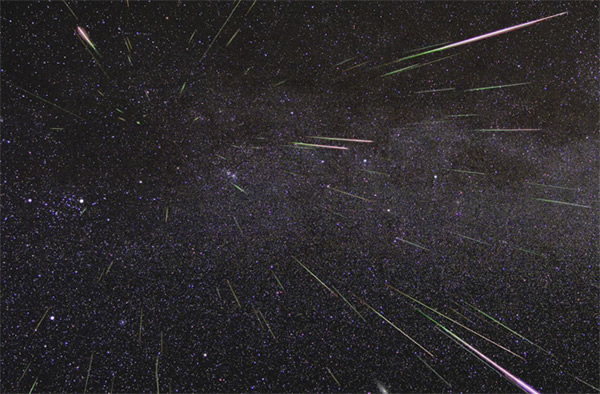Geminid Meteor Shower Peaks Tonight
The Geminid meteor shower happens when the Earth passes through the dust trail of asteroid 3200 Phaethon.
One of the best meteor showers of the year is set to put on a performance tonight (Dec. 13), but if you can't catch the cosmic display in person, you can watch it live online.
The Geminid meteor shower — named for the constellation Gemini — is peaking late tonight into Saturday morning, potentially treating stargazers in light-free areas to about 90 to 120 meteors per hour. Observers can expect to get the best views of the shower, weather permitting, at around 4 a.m. local time in the wee hours of Saturday morning after the waxing moon sets, according to Bill Cooke, head of NASA's Meteoroid Environment Office.
"This year, there will be a magic hour starting at about 4 a.m. up until dawn that there will be no moon and you'll be able to see the Geminids in their full glory," Cooke told reporters on Dec. 11. Space fans everywhere can catch the meteor show live online through two webcasts from the online Slooh Space Camera and NASA. You can watch both NASA and Slooh's live webcasts on SPACE.com.
NASA is hosting a web chat about the meteor shower beginning at 11 p.m. EST (0400 Dec. 14 GMT). Cooke and two of his team members — Danielle Moser and Rhiannon Blaauw — will answer questions from the public about the Geminids during the "up all night" webcast. The chat is expected to run until 3 a.m. EST (0800 GMT) and can be seen here.
Slooh will provide a free live feed of the Geminids from an observatory on the Canary Islands starting at 5:30 p.m. EST (2230 GMT) and running into the night, ending at 1 a.m. EST (0600 GMT). You can watch the webcast directly at www.slooh.com or by using the space camera's iPad app.
Geminid meteors appear to radiate from the constellation Gemini and have a reputation for being bright and slow. The shower can also produce brilliant fireballs that streak through the sky.
"The best thing to do to observe meteors is to lie flat on your back and look straight up," Cooke said. "You don't want to look at Gemini, you just want to look straight up and take in as much of the sky as possible because meteors can appear anywhere in the sky and the more sky you see, the better you chance of seeing a meteor."
Meteor showers are created when Earth passes through streams of debris left behind by asteroids or comets. Pieces of space rock and dust are in space are called meteoroids and they become meteors when they burn up in the atmosphere. Meteorites are pieces of meteors that make it to Earth's surface.
The Geminid shower happens every year when Earth passes through the trail of debris left behind the asteroid 3200 Phaethon. The meteor display was first officially detected in the 1800s when the peak was marked by only 20 meteors per hour.
"Those rates have increased over the almost two centuries since then by up to over 120 an hour," Cooke said. "This is because Jupiter's gravity is tugging that string of debris that comprises the Geminids closer to Earth as time goes along. Geminid rates over the next decade or century could exceed over 200 per hour."(Dec 13, 2013 03:51 PM ET // by Miriam Kramer, SPACE.com)












